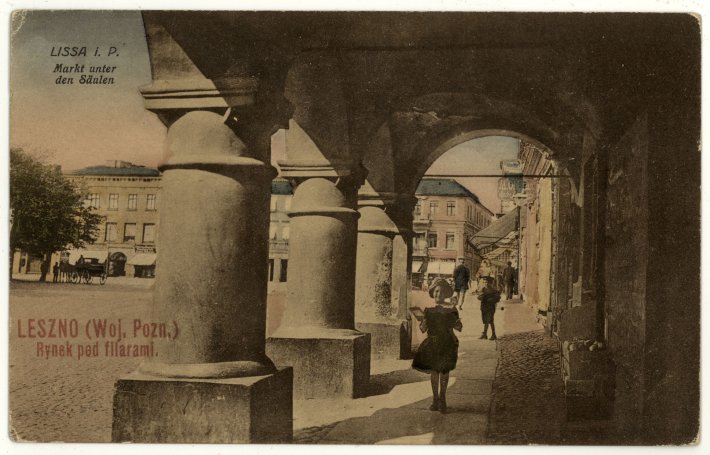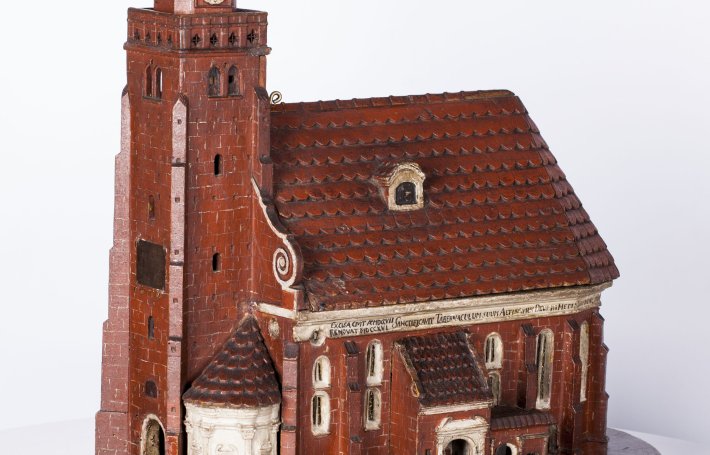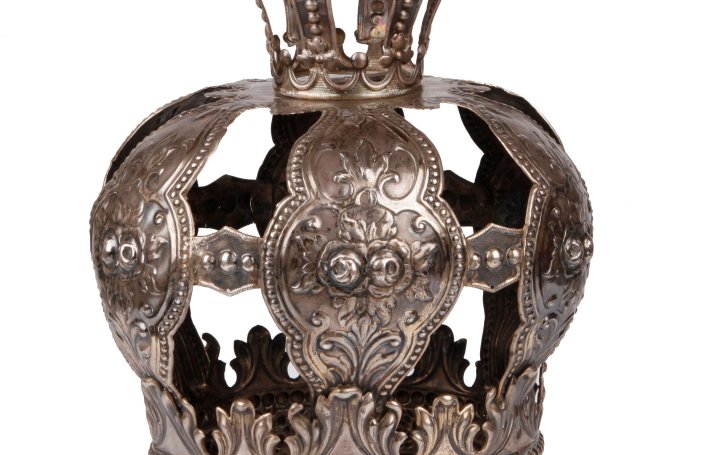Collections
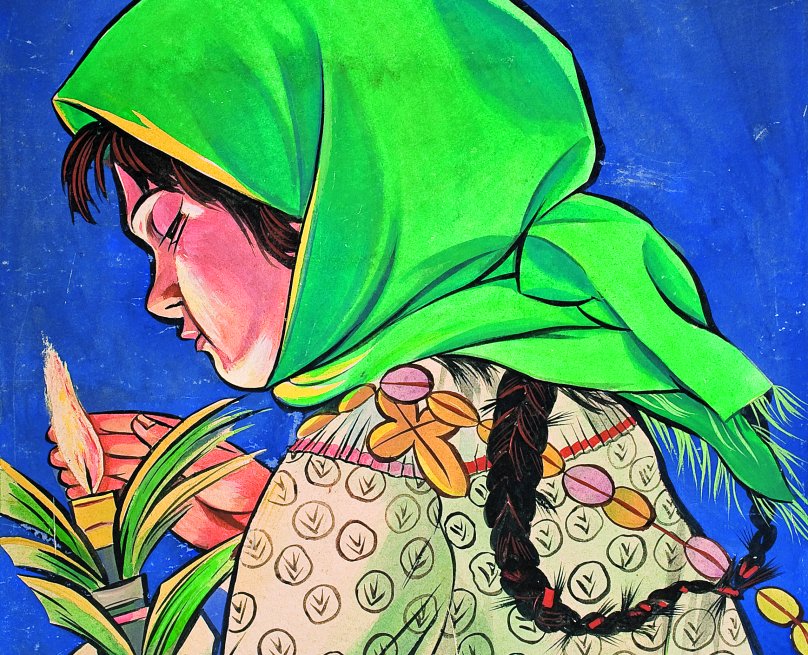
We invite you to discover the wealth of our museum collections! Our collections are a real treasury of history and art, covering various fields and eras. Among them you will find:
Visit our museum to immerse yourself in these fascinating collections and discover the stories they tell.
- Traditional Culture Collections: A fascinating overview of the everyday life and customs of our ancestors.
- Judaica: Valuable items and artifacts related to Jewish heritage.
- Protestant Culture Collections: Unique exhibits illustrating the life and faith of Protestant communities.
- Old Prints: Priceless books and documents that have survived the centuries.
- The history of Leszno: The history of our city in a nutshell, told through various objects.
- Coffin Portraits: A unique collection of images that were traditionally placed on coffins.
- Polish Painting: Exceptional works of Polish artists, from classical masters to contemporary talents.
- Crafts: Examples of masterly craftsmanship of utilitarian and decorative items.
Visit our museum to immerse yourself in these fascinating collections and discover the stories they tell.
The history of Leszno and the region until the end of the eighteenth century
Archaeology
The archaeological collections, numbering about 300 objects, are represented by all archaeological epochs. From the younger period of the Stone Age (Neolithic 4500 – 1650 BC) come stone axes and axes. The Bronze Age (1650 – 550 BCE) is represented mainly by functional and ritual ceramics, as well as ornaments, clasps made of bronze, used to fasten elements of clothing and tools. Relatively few are the collections from the Lathenian period (400 BCE – 0) and the Roman period (0 – 500 CE). Two very valuable objects come from the early Middle Ages (500 – 1250 AD): a war sword from the 13th century and a treasure of silver coins from the 11th century minted, among others, in France, England and Hungary. The sword was fished out of Lake Łoniewskie in the interwar period. It was probably the property of Przemysł II, Duke of Greater Poland, later King of Poland. One of the most interesting exhibits are the horns of the aurochs, which symbolically refer to the legend of the knight Wieniawa and the beginnings of Leszno.
Archives
The archive collection includes documents relating to the history of Leszno. These are municipal files, which include: confirmations of privileges, certificates of citizenship, guild statutes, craft recommendations, protocols and master craftsmen's diplomas. Among the town records, the confirmations of municipal privileges for the towns of Leszno and Wschowa deserve attention. In the first one, in 1676, King Jan III Sobieski confirmed all the previous privileges granted to the town of Leszno. The second privilege was confirmed by the last king of Poland, Stanisław August Poniatowski in 1792.
Guild recommendations come from the 17th and 18th centuries and concern craft guilds operating in many cities of Greater Poland. The oldest recommendation was issued in 1667 for a member of butcher's guild of the town of Śmigiel.
Military
The collection of militaria includes: cold steel and firearms. Within cold steel, there are bladed and polearm weapons. The Polish carabel from the seventeenth century is noteworthy. The polearms in the group are partisans from the 17th century and halberds and war pitchforks from the 18th century. Firearms are pistols and shotguns from the 18th century.
Numismatics and medallic art
The numismatic collection has been collected since the beginning of the Museum's existence. The core of the collection consists of coins donated at the turn of the 40s and 50s of the twentieth century by the municipal authorities and private individuals. In the collection of numismatic items, one can distinguish a fairly consistent overview of the coinage of some Polish rulers and the countries of the German Reich. The oldest numismatic coins in the collection are Polish coins, including half-grosz, and denars from the Jagiellonian times. The period of the reign of Zygmunt III Waza is represented by one-and-a-half pieces, three-pieces, ducats, sixes and szelągs, while two-grosz coins, six-grosz coins, Lithuanian orts and boratins come from the era of Jan Kazimierz. The rest of the collection consists of individual examples of coins dating back to the reign of the last king of Poland - Stanisław August Poniatowski. Among the collected banknotes, one of the most interesting is a banknote issued during the Kościuszko Uprising in 1794 with a face value of 4 zlotys - the first paper money in Poland at that time. In turn, a unique example of 18th-century medal art is the coronation medal of King of Poland Stanisław Leszczyński from 1704, which complements interesting iconographic collections.
The archaeological collections, numbering about 300 objects, are represented by all archaeological epochs. From the younger period of the Stone Age (Neolithic 4500 – 1650 BC) come stone axes and axes. The Bronze Age (1650 – 550 BCE) is represented mainly by functional and ritual ceramics, as well as ornaments, clasps made of bronze, used to fasten elements of clothing and tools. Relatively few are the collections from the Lathenian period (400 BCE – 0) and the Roman period (0 – 500 CE). Two very valuable objects come from the early Middle Ages (500 – 1250 AD): a war sword from the 13th century and a treasure of silver coins from the 11th century minted, among others, in France, England and Hungary. The sword was fished out of Lake Łoniewskie in the interwar period. It was probably the property of Przemysł II, Duke of Greater Poland, later King of Poland. One of the most interesting exhibits are the horns of the aurochs, which symbolically refer to the legend of the knight Wieniawa and the beginnings of Leszno.
Archives
The archive collection includes documents relating to the history of Leszno. These are municipal files, which include: confirmations of privileges, certificates of citizenship, guild statutes, craft recommendations, protocols and master craftsmen's diplomas. Among the town records, the confirmations of municipal privileges for the towns of Leszno and Wschowa deserve attention. In the first one, in 1676, King Jan III Sobieski confirmed all the previous privileges granted to the town of Leszno. The second privilege was confirmed by the last king of Poland, Stanisław August Poniatowski in 1792.
Guild recommendations come from the 17th and 18th centuries and concern craft guilds operating in many cities of Greater Poland. The oldest recommendation was issued in 1667 for a member of butcher's guild of the town of Śmigiel.
Military
The collection of militaria includes: cold steel and firearms. Within cold steel, there are bladed and polearm weapons. The Polish carabel from the seventeenth century is noteworthy. The polearms in the group are partisans from the 17th century and halberds and war pitchforks from the 18th century. Firearms are pistols and shotguns from the 18th century.
Numismatics and medallic art
The numismatic collection has been collected since the beginning of the Museum's existence. The core of the collection consists of coins donated at the turn of the 40s and 50s of the twentieth century by the municipal authorities and private individuals. In the collection of numismatic items, one can distinguish a fairly consistent overview of the coinage of some Polish rulers and the countries of the German Reich. The oldest numismatic coins in the collection are Polish coins, including half-grosz, and denars from the Jagiellonian times. The period of the reign of Zygmunt III Waza is represented by one-and-a-half pieces, three-pieces, ducats, sixes and szelągs, while two-grosz coins, six-grosz coins, Lithuanian orts and boratins come from the era of Jan Kazimierz. The rest of the collection consists of individual examples of coins dating back to the reign of the last king of Poland - Stanisław August Poniatowski. Among the collected banknotes, one of the most interesting is a banknote issued during the Kościuszko Uprising in 1794 with a face value of 4 zlotys - the first paper money in Poland at that time. In turn, a unique example of 18th-century medal art is the coronation medal of King of Poland Stanisław Leszczyński from 1704, which complements interesting iconographic collections.

History of Leszno and the region 19th century - 1939
The most diverse collection covers the period from the beginning of the 19th century to the times of the Polish People's Republic, and includes documents and various objects illustrating social, economic and cultural life.
Among them, the exhibits related to the activities of organizations and associations that operated in Leszno and surrounding towns during the partitions and the interwar period are noteworthy. These include: a uniform of a member of the "Sokół" Gymnastic Society and the riflemen's fraternities, weapons, shooting targets and decorations. Among the valuable archives are minutes, acts of granting city citizenship and association files. A significant collection concerns two regiments stationed in Leszno since the early 1920s: the 55th Infantry Regiment and the 17th Uhlan Regiment, including: photos, military items (sabers, helmets, uhlan lances), as well as uniforms of these formations.
World War II is represented by postcards with views of Leszno and the surrounding area, photos, documents, Polish uniforms and a few military items (bayonets and "szaszka" of the Red Army). From the period of the Polish People's Republic we should mention decorations, a few postcards and leaflets, as well as exhibits related to the Central Harvest Festival in Leszno in 1977.
Interesting collections include a set of 19th- and 20th-century coins, including Prussian coins and substitute money in circulation in the city of Leszno during World War I and II and the Polish People's Republic, as well as commemorative medals issued to commemorate events related to the history of Leszno.
Among them, the exhibits related to the activities of organizations and associations that operated in Leszno and surrounding towns during the partitions and the interwar period are noteworthy. These include: a uniform of a member of the "Sokół" Gymnastic Society and the riflemen's fraternities, weapons, shooting targets and decorations. Among the valuable archives are minutes, acts of granting city citizenship and association files. A significant collection concerns two regiments stationed in Leszno since the early 1920s: the 55th Infantry Regiment and the 17th Uhlan Regiment, including: photos, military items (sabers, helmets, uhlan lances), as well as uniforms of these formations.
World War II is represented by postcards with views of Leszno and the surrounding area, photos, documents, Polish uniforms and a few military items (bayonets and "szaszka" of the Red Army). From the period of the Polish People's Republic we should mention decorations, a few postcards and leaflets, as well as exhibits related to the Central Harvest Festival in Leszno in 1977.
Interesting collections include a set of 19th- and 20th-century coins, including Prussian coins and substitute money in circulation in the city of Leszno during World War I and II and the Polish People's Republic, as well as commemorative medals issued to commemorate events related to the history of Leszno.

Traditional culture collections
Our traditional culture collections consist of objects and artifacts that document the culture and life of communities from southwestern Greater Poland, including the subregions of Biskupizna, Chazów/Hazów and Bukówiec Górny. We collect ethnographic objects to understand human experiences and imaginations.
Folk costume
The collection includes folk costumes from southwestern Greater Poland and beyond. An important part of the collection are tulle bonnets of various types, including biskupiański bonnets with eaves and flaps, Khazac bonnets, Kościan krymy, Włoszakowice bonnets, Kąkolewo bonnets, Krotoszyn bonnets and others. They are accompanied by tulle ties, silk ribbons with flowers and ruffs. They show the beauty of Greater Poland embroidery. Other interesting elements of the outfit include: scarves, skirts, aprons, jackets, vests and wołoshkas.
Folk art
The most representative branch of folk art is sculpture. The oldest works in the collection come from the 19th century. In addition to anonymous cult figures, we have works by Franciszek Nowak from Raszewy, the author of many roadside crosses and shrines. In the first half of the 20th century, Andrzej Majchrzak was active in the vicinity of Leszno and Gostyń, and Ludwik Kwaczyński in the vicinity of Przemęt. The collection also includes religious paintings, including those painted on glass. A large collection consists of folk art from the 2nd half of the 20th century.
Ceramics
The ceramics collection includes clay, stoneware, earthenware and porcelain vessels from the 17th to the 20th century. These are both products made in local pottery workshops, as well as factory production, including: from Bochnia, Bolesławiec, Włocławek, Koło, Chodzież. The decoration of the collection are examples of Pokutian and Moroccan ceramics.
Country farm
The old country houses were filled with wooden furniture and equipment, among which there are the painted wine chests from our collection. We also have tools for everyday work, including: related to fabric production, hygiene, home processing and food preparation. In addition, a small collection of agricultural tools.
Rural crafts
The collection includes tools and equipment from former rural workshops. The items present the way of work of a blacksmith, carpenter, cooper, wheelwright and shoemaker. An interesting collection consists of the tools of kopczarki making tulle bonnets.
Folk costume
The collection includes folk costumes from southwestern Greater Poland and beyond. An important part of the collection are tulle bonnets of various types, including biskupiański bonnets with eaves and flaps, Khazac bonnets, Kościan krymy, Włoszakowice bonnets, Kąkolewo bonnets, Krotoszyn bonnets and others. They are accompanied by tulle ties, silk ribbons with flowers and ruffs. They show the beauty of Greater Poland embroidery. Other interesting elements of the outfit include: scarves, skirts, aprons, jackets, vests and wołoshkas.
Folk art
The most representative branch of folk art is sculpture. The oldest works in the collection come from the 19th century. In addition to anonymous cult figures, we have works by Franciszek Nowak from Raszewy, the author of many roadside crosses and shrines. In the first half of the 20th century, Andrzej Majchrzak was active in the vicinity of Leszno and Gostyń, and Ludwik Kwaczyński in the vicinity of Przemęt. The collection also includes religious paintings, including those painted on glass. A large collection consists of folk art from the 2nd half of the 20th century.
Ceramics
The ceramics collection includes clay, stoneware, earthenware and porcelain vessels from the 17th to the 20th century. These are both products made in local pottery workshops, as well as factory production, including: from Bochnia, Bolesławiec, Włocławek, Koło, Chodzież. The decoration of the collection are examples of Pokutian and Moroccan ceramics.
Country farm
The old country houses were filled with wooden furniture and equipment, among which there are the painted wine chests from our collection. We also have tools for everyday work, including: related to fabric production, hygiene, home processing and food preparation. In addition, a small collection of agricultural tools.
Rural crafts
The collection includes tools and equipment from former rural workshops. The items present the way of work of a blacksmith, carpenter, cooper, wheelwright and shoemaker. An interesting collection consists of the tools of kopczarki making tulle bonnets.
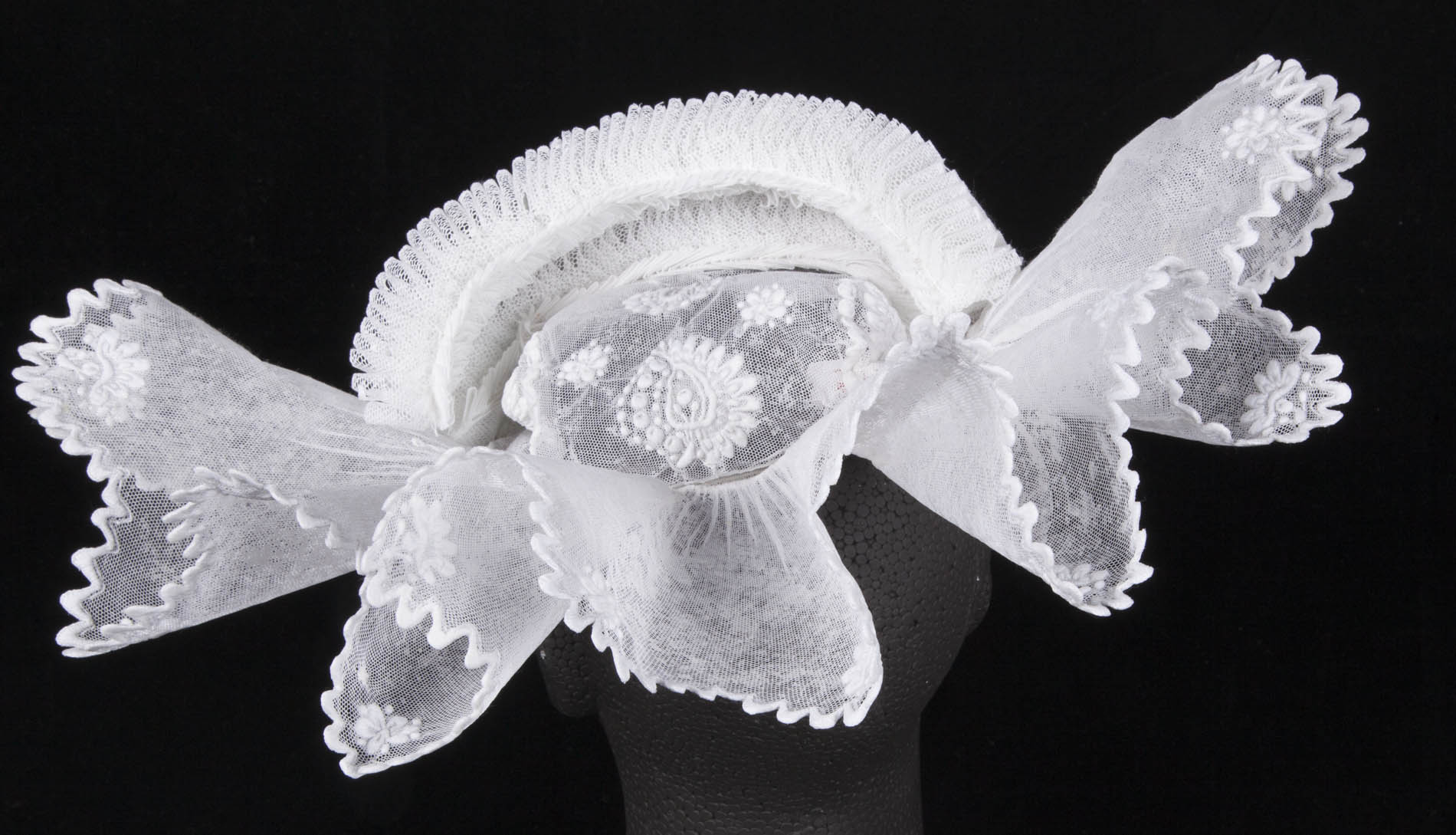
Painting
Polish painting
The collection of Polish paintings on rural themes dates back to the 1950s. Today it has approximately 800 paintings, including works emphasizing the cultural richness of Greater Poland. The collection is dominated by works related to the artistic environment of Munich, to which many Polish painters belonged in the 19th century, including such outstanding artists as Józef Chełmoński, Julian Fałat, Juliusz Kossak, Wacław Szymanowski and Leon Wyczółkowski. Their works are in the Museum's collection. Other names in the collection include, m.in, Kazimierz Alchimowicz, Teodor Axentowicz, Władysław Jarocki, Aleksander Kotsis, Antoni Kozakiewicz, Stanisław Łasiński, Jacek Malczewski, Józef Rapacki, Kazimierz Sichulski, Włodzimierz Tetmajer, Henryk Weyssenhoff and Stanisław Wyspiański. A large group in the collection consists of paintings from the years of the Second Polish Republic, which are the works of artists who grew up in the atmosphere of stylistic changes of that period. The collection includes works by such artists as: Jan Cybis, Eugeniusz Eibisch, Erwin Elster, Alfred Lenica, Ewa Łunkiewicz-Rogoyska, Rafał Malczewski, Fryderyk Pautsch, Władysław Skoczylas, Zofia Stryjeńska, Eustachy Wasilkowski and Wojciech Weiss, as well as a collection of works by Leszno artists from the interwar period, including works by Wilhelm Ballarin, Romuald Bogaczyk and Karol Hebenstreit.
Portraits of the Fowler Kings
A clear manifestation of the splendor of the townspeople living in the 18th and 19th centuries in Leszno is the collection of images of fowler kings, consisting of 83 objects. It is a unique and one of a kind collection of bourgeois portraits preserved in Greater Poland. Chronologically it falls into 1715 and 1936. Their performers were painters from local painting workshops: Johann Christian Pauli, Casper Gottfried Bencke, Gottlieb Rontz, Gottfried Arndt, Ferdynand Gregor, Wilhelm Ballarin, as well as artists from outside Leszno: Georg Raschke, Jan Simon, Mieczysław Kościelniak. The entire complex has great iconographic and documentary value, e.g. regarding the history of the costumes and customs of the fowler brotherhoods, and is finally a valuable source of knowledge about the Leszno middle class at that time.
Coffin portraits
The most valuable collection of the museum includes a set of coffin portraits, which closes chronologically in the years 1715–175 and consists mostly of portraits from the former church of the Bohemian Brethren of St. John in Leszno. They depict images of men and women from local noble families: Bronikowski, Dziembowski, Karczewski, Mielęcki, Potworowski, Złotnicki and Żychliński. Despite its workshop traditionalism it is a complex with special painting qualities. These portraits were painted by local guild painters, on metal sheets made in the workshops of the casting of Leszno and other craft centres of the Greater Poland-Silesia borderland. The portraits from our collection have been preserved along with inscription and coat of arms plaques, which is a historical value of the collection.
Portraits of the 17th–19th centuries
The collection of portraits includes nearly 200 works from the 17th-19th centuries. The works included in it were created mostly in local painting workshops, but also came from the brushes of foreign artists. The collection includes: portraits of the court, nobility, bourgeois and landed gentry. Among the court portraits attention is drawn to the oldest portrait of Frederick V, the so-called winter king from the first half of the 17th century. An important role in the collection is played by portraits of King Stanisław Leszczyński, among others by Daniel Klein, and portraits of his wife Katarzyna Leszczyńska née Opalińska and daughter Maria, wife of King Louis XV of France. A special example of portrait art is a child. Four representative images of sons of Prince Aleksander Józef Sułkowski from the second quarter of the 18th century form a rare, uniform set of children's portraits.
The collection of Polish paintings on rural themes dates back to the 1950s. Today it has approximately 800 paintings, including works emphasizing the cultural richness of Greater Poland. The collection is dominated by works related to the artistic environment of Munich, to which many Polish painters belonged in the 19th century, including such outstanding artists as Józef Chełmoński, Julian Fałat, Juliusz Kossak, Wacław Szymanowski and Leon Wyczółkowski. Their works are in the Museum's collection. Other names in the collection include, m.in, Kazimierz Alchimowicz, Teodor Axentowicz, Władysław Jarocki, Aleksander Kotsis, Antoni Kozakiewicz, Stanisław Łasiński, Jacek Malczewski, Józef Rapacki, Kazimierz Sichulski, Włodzimierz Tetmajer, Henryk Weyssenhoff and Stanisław Wyspiański. A large group in the collection consists of paintings from the years of the Second Polish Republic, which are the works of artists who grew up in the atmosphere of stylistic changes of that period. The collection includes works by such artists as: Jan Cybis, Eugeniusz Eibisch, Erwin Elster, Alfred Lenica, Ewa Łunkiewicz-Rogoyska, Rafał Malczewski, Fryderyk Pautsch, Władysław Skoczylas, Zofia Stryjeńska, Eustachy Wasilkowski and Wojciech Weiss, as well as a collection of works by Leszno artists from the interwar period, including works by Wilhelm Ballarin, Romuald Bogaczyk and Karol Hebenstreit.
Portraits of the Fowler Kings
A clear manifestation of the splendor of the townspeople living in the 18th and 19th centuries in Leszno is the collection of images of fowler kings, consisting of 83 objects. It is a unique and one of a kind collection of bourgeois portraits preserved in Greater Poland. Chronologically it falls into 1715 and 1936. Their performers were painters from local painting workshops: Johann Christian Pauli, Casper Gottfried Bencke, Gottlieb Rontz, Gottfried Arndt, Ferdynand Gregor, Wilhelm Ballarin, as well as artists from outside Leszno: Georg Raschke, Jan Simon, Mieczysław Kościelniak. The entire complex has great iconographic and documentary value, e.g. regarding the history of the costumes and customs of the fowler brotherhoods, and is finally a valuable source of knowledge about the Leszno middle class at that time.
Coffin portraits
The most valuable collection of the museum includes a set of coffin portraits, which closes chronologically in the years 1715–175 and consists mostly of portraits from the former church of the Bohemian Brethren of St. John in Leszno. They depict images of men and women from local noble families: Bronikowski, Dziembowski, Karczewski, Mielęcki, Potworowski, Złotnicki and Żychliński. Despite its workshop traditionalism it is a complex with special painting qualities. These portraits were painted by local guild painters, on metal sheets made in the workshops of the casting of Leszno and other craft centres of the Greater Poland-Silesia borderland. The portraits from our collection have been preserved along with inscription and coat of arms plaques, which is a historical value of the collection.
Portraits of the 17th–19th centuries
The collection of portraits includes nearly 200 works from the 17th-19th centuries. The works included in it were created mostly in local painting workshops, but also came from the brushes of foreign artists. The collection includes: portraits of the court, nobility, bourgeois and landed gentry. Among the court portraits attention is drawn to the oldest portrait of Frederick V, the so-called winter king from the first half of the 17th century. An important role in the collection is played by portraits of King Stanisław Leszczyński, among others by Daniel Klein, and portraits of his wife Katarzyna Leszczyńska née Opalińska and daughter Maria, wife of King Louis XV of France. A special example of portrait art is a child. Four representative images of sons of Prince Aleksander Józef Sułkowski from the second quarter of the 18th century form a rare, uniform set of children's portraits.
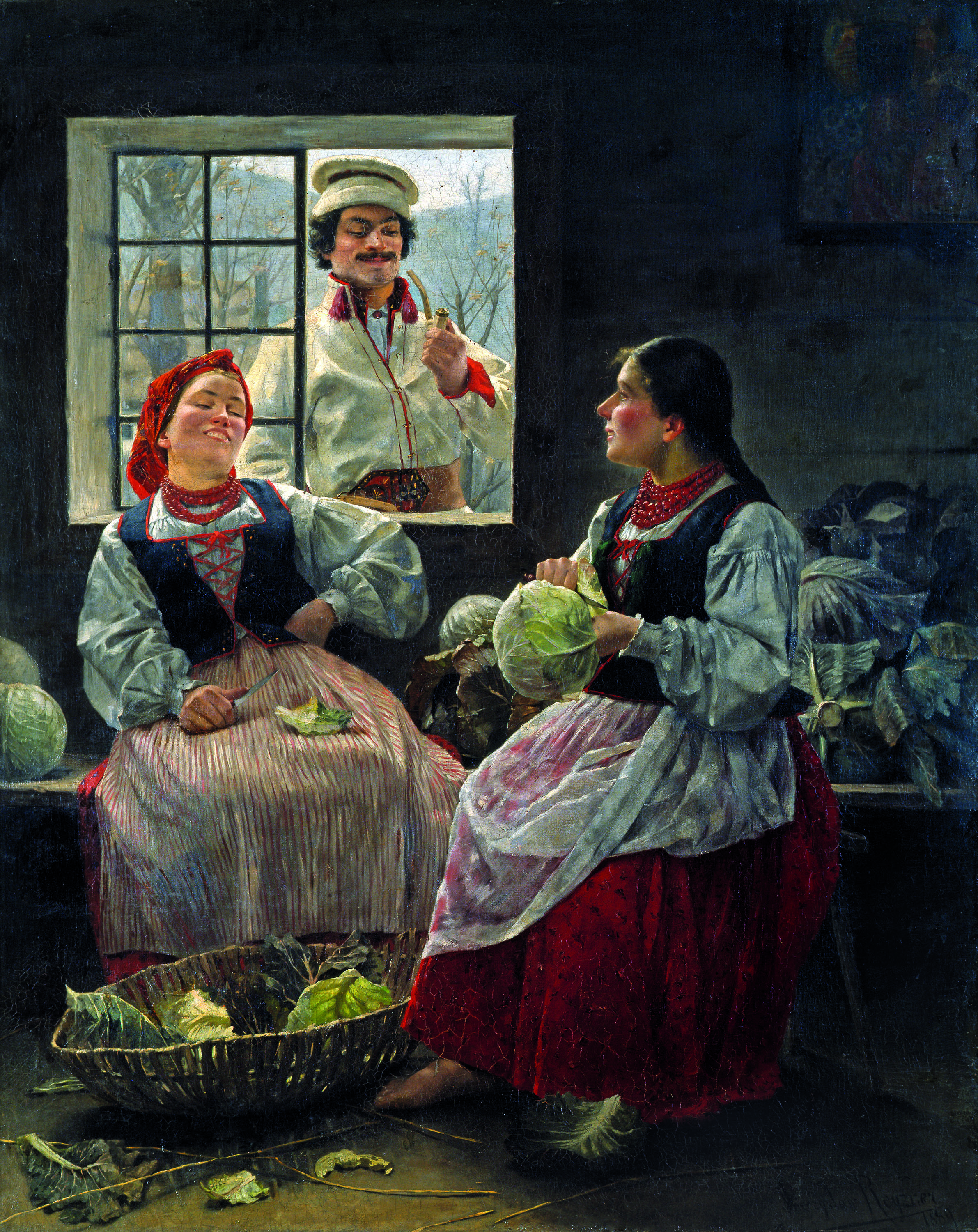
Handicrafts and everyday objects
Looking at the objects collected in this collection, we can move into the everyday world of magnates, nobles and townspeople living in the 17th-20th centuries. Among the various objects we find outstanding works of artistic craftsmanship as well as craft or factory products. They illustrate the standard of living of the inhabitants of Leszno and the surrounding area.
Metal objects
The collection includes goldsmiths, tin vessels and objects made of iron. Leszno was a well-known goldsmith's center, and local goldsmiths had their guild, including painters in the 17th and 18th centuries. Tableware, liturgical objects and jewelry were made. In addition to goldsmiths, there were also konwisarze, i.e. manufacturers of tin vessels, working in Leszno. The collected plates, cups and bowls were created in Leszno, but also in Wschowa and Silesia. Iron exhibits include mainly decorative baroque door handles and door fittings.
Ceramics
The ceramics collection includes stoneware, faience and porcelain vessels. One of the oldest exhibits is the 17th century stoneware jug from the Rhineland, excavated in Leszno at B.Chrobrego Sreet. The greatest treasures include 18th-century plates from Miśnia decorated with floral patterns, dishes from the Royal Porcelain Manufactory in Berlin and plates from Copenhagen. The faience dishes include 19th-century plates from English manufacturers, including a plate with the monogram of Maciej Mielżyński from Pawłowice.
Furniture
The most impressive piece of furniture is a wardrobe made in Silesia, dating from the 18th century. Baroque furniture also includes a corner cabinet and numerous trunks and chests. Many 19th-century furniture refers to the Biedermeier style. Sofas, chairs and tables invite you to relax.
Textiles
The collected textiles come from the end of the 19th century and the first half of the 20th century. These are mainly bed linen, table linen and personal linen. These exhibits, despite their utilitarian functions, are richly decorated. The collection also includes crocheted napkins. The attention to details and elegance of every detail of everyday life is visible in each of these objects.
Metal objects
The collection includes goldsmiths, tin vessels and objects made of iron. Leszno was a well-known goldsmith's center, and local goldsmiths had their guild, including painters in the 17th and 18th centuries. Tableware, liturgical objects and jewelry were made. In addition to goldsmiths, there were also konwisarze, i.e. manufacturers of tin vessels, working in Leszno. The collected plates, cups and bowls were created in Leszno, but also in Wschowa and Silesia. Iron exhibits include mainly decorative baroque door handles and door fittings.
Ceramics
The ceramics collection includes stoneware, faience and porcelain vessels. One of the oldest exhibits is the 17th century stoneware jug from the Rhineland, excavated in Leszno at B.Chrobrego Sreet. The greatest treasures include 18th-century plates from Miśnia decorated with floral patterns, dishes from the Royal Porcelain Manufactory in Berlin and plates from Copenhagen. The faience dishes include 19th-century plates from English manufacturers, including a plate with the monogram of Maciej Mielżyński from Pawłowice.
Furniture
The most impressive piece of furniture is a wardrobe made in Silesia, dating from the 18th century. Baroque furniture also includes a corner cabinet and numerous trunks and chests. Many 19th-century furniture refers to the Biedermeier style. Sofas, chairs and tables invite you to relax.
Textiles
The collected textiles come from the end of the 19th century and the first half of the 20th century. These are mainly bed linen, table linen and personal linen. These exhibits, despite their utilitarian functions, are richly decorated. The collection also includes crocheted napkins. The attention to details and elegance of every detail of everyday life is visible in each of these objects.
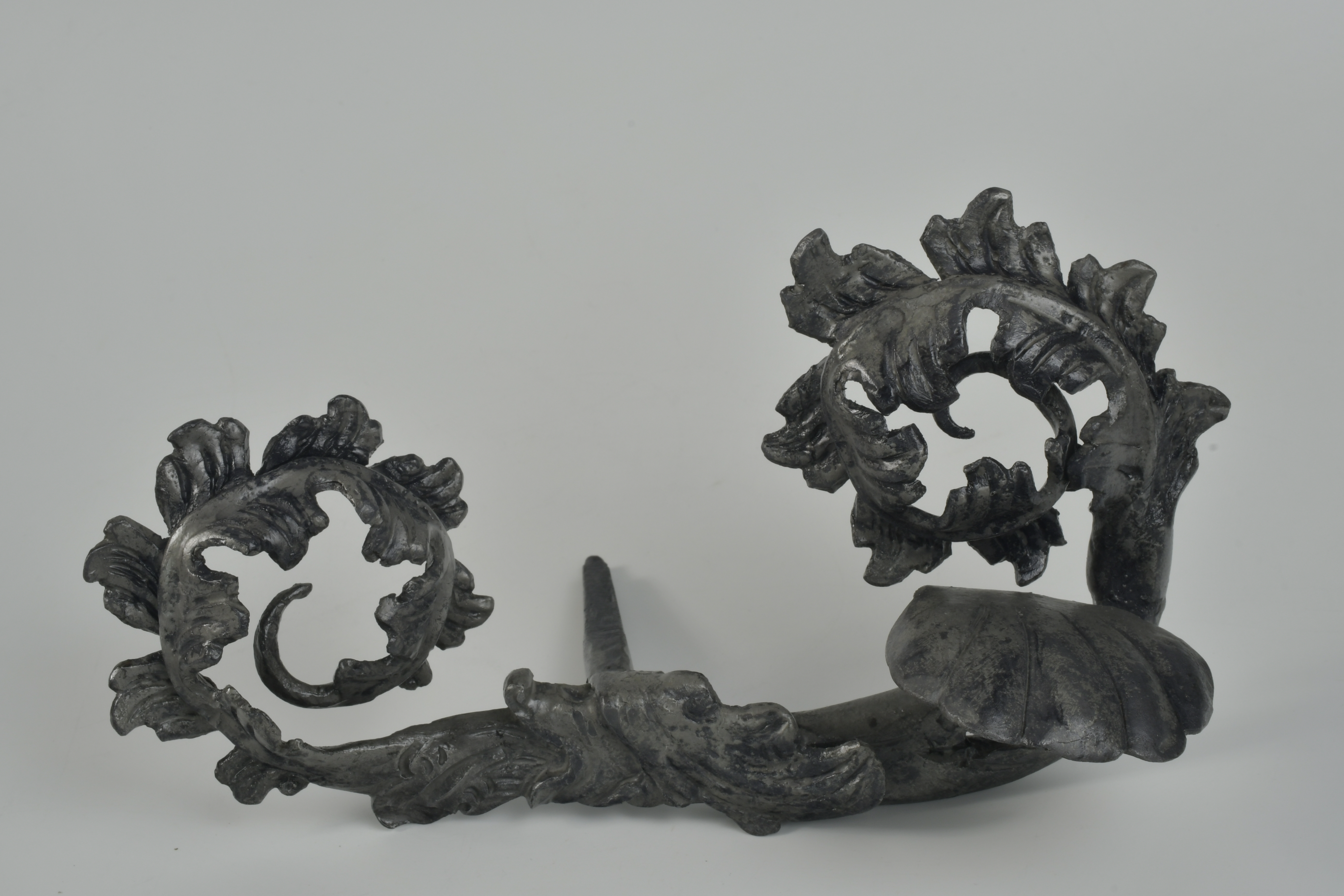
Others
Judaica
We have been collecting Judaica since 1993. The collection consists of objects of religious, synagogue and domestic worship, paintings and graphics, as well as historical memorabilia related to the history of the Jewish community in Greater Poland. Their diverse nature allows them to present a rich Jewish culture and promote Jewish heritage. For this purpose, we conduct educational activities and organize meetings devoted to this topic. The artefacts related to the Jewish ritual, including Torah decorations (Hebrew: glue-kodesh), synagogue fabrics and elements of ritual attire are of particular value. A similar group of exhibits are objects related to the celebration of holidays and family celebrations and everyday religious practice. They are complemented by souvenirs, documents and archival photographs illustrating the life of Jews in Leszno and the surrounding towns. The collection is constantly being complemented. Selected Judaica are presented at the permanent exhibition "At the meeting point of worlds. The history of Leszno from the 16th to the 20th century".
Protestant heritage
For over 300 years Leszno was a significant center of Protestantism: the "capital" of the Unity of the Bohemian Brethren and one of the most important centers of Lutheranism and Calvinism in Greater Poland. An interesting heritage has remained of these communities – a fragment of it is in the collection of the Leszno museum.
Old prints and prints up to the mid-twentieth century
In the museum library, apart from the collection of publications necessary for substantive work, there are over 400 old prints. Among them, evangelical, lutheran and calvinist religious works dominate. It consists of editions of songbooks and prayer books, polemical texts and theological treatises.
Iconographic collection
The museum has an interesting collection of iconographic objects that illustrate urban planning, life of old Leszno and the region.
It opens with graphic panoramas of Leszno – including the oldest veduta from the mid-seventeenth century and eighteenth-century views by Bernhard Friedrich Werner.
An important core of the iconographic collection is a collection of photographs documenting the architecture of Leszno and everyday life.The collection is represented by the works of such photographers as Ottomar and Georg Anschütz, Udo Mertens, Wilhelm Juretzky, Karl Feichtner and Tadeusz Semrau.
The collection also includes photos from the 19th century, the interwar period and the Nazi occupation. The collection consists of about 3580 objects. They complement the paintings whose theme is the old Leszno, especially from the interwar period, documented by the works of local artists m.in. Wilhelm Ballarin, Romuald Bogaczyk and Józef Skoracki.
We have been collecting Judaica since 1993. The collection consists of objects of religious, synagogue and domestic worship, paintings and graphics, as well as historical memorabilia related to the history of the Jewish community in Greater Poland. Their diverse nature allows them to present a rich Jewish culture and promote Jewish heritage. For this purpose, we conduct educational activities and organize meetings devoted to this topic. The artefacts related to the Jewish ritual, including Torah decorations (Hebrew: glue-kodesh), synagogue fabrics and elements of ritual attire are of particular value. A similar group of exhibits are objects related to the celebration of holidays and family celebrations and everyday religious practice. They are complemented by souvenirs, documents and archival photographs illustrating the life of Jews in Leszno and the surrounding towns. The collection is constantly being complemented. Selected Judaica are presented at the permanent exhibition "At the meeting point of worlds. The history of Leszno from the 16th to the 20th century".
Protestant heritage
For over 300 years Leszno was a significant center of Protestantism: the "capital" of the Unity of the Bohemian Brethren and one of the most important centers of Lutheranism and Calvinism in Greater Poland. An interesting heritage has remained of these communities – a fragment of it is in the collection of the Leszno museum.
Old prints and prints up to the mid-twentieth century
In the museum library, apart from the collection of publications necessary for substantive work, there are over 400 old prints. Among them, evangelical, lutheran and calvinist religious works dominate. It consists of editions of songbooks and prayer books, polemical texts and theological treatises.
Iconographic collection
The museum has an interesting collection of iconographic objects that illustrate urban planning, life of old Leszno and the region.
It opens with graphic panoramas of Leszno – including the oldest veduta from the mid-seventeenth century and eighteenth-century views by Bernhard Friedrich Werner.
An important core of the iconographic collection is a collection of photographs documenting the architecture of Leszno and everyday life.The collection is represented by the works of such photographers as Ottomar and Georg Anschütz, Udo Mertens, Wilhelm Juretzky, Karl Feichtner and Tadeusz Semrau.
The collection also includes photos from the 19th century, the interwar period and the Nazi occupation. The collection consists of about 3580 objects. They complement the paintings whose theme is the old Leszno, especially from the interwar period, documented by the works of local artists m.in. Wilhelm Ballarin, Romuald Bogaczyk and Józef Skoracki.

